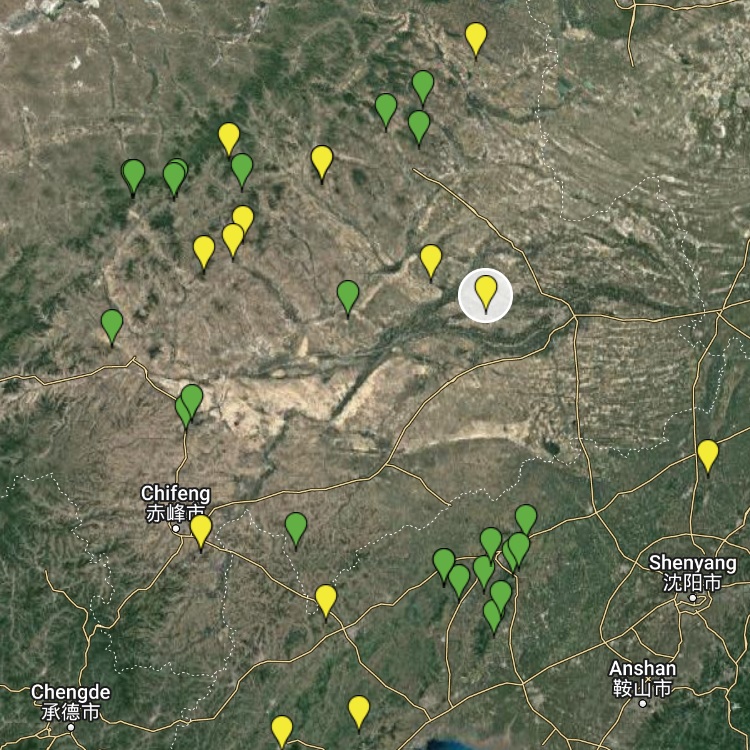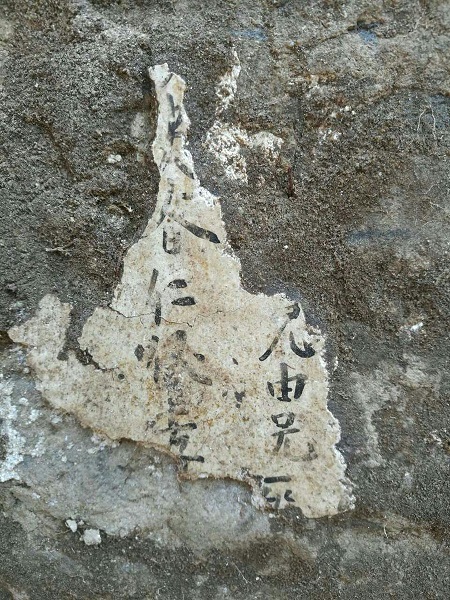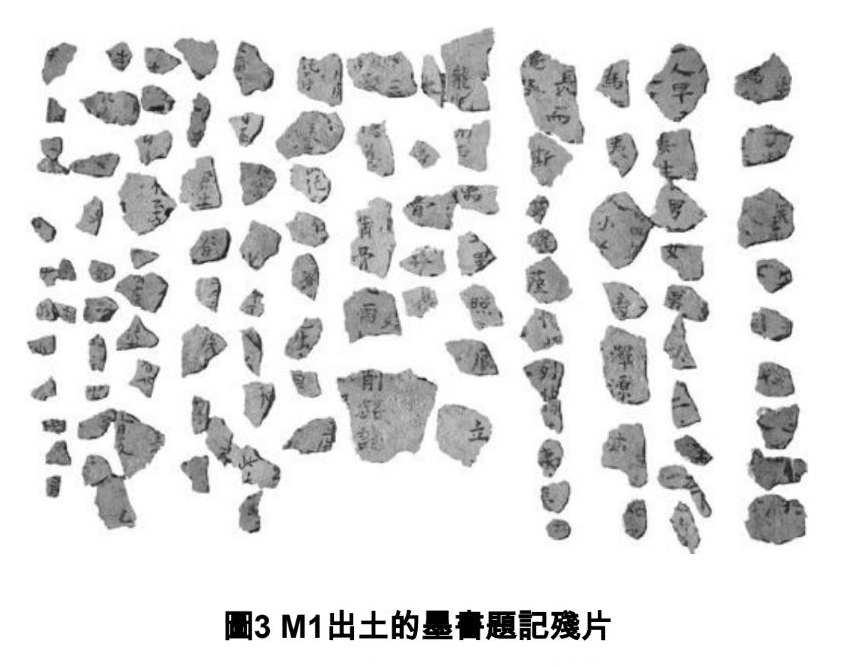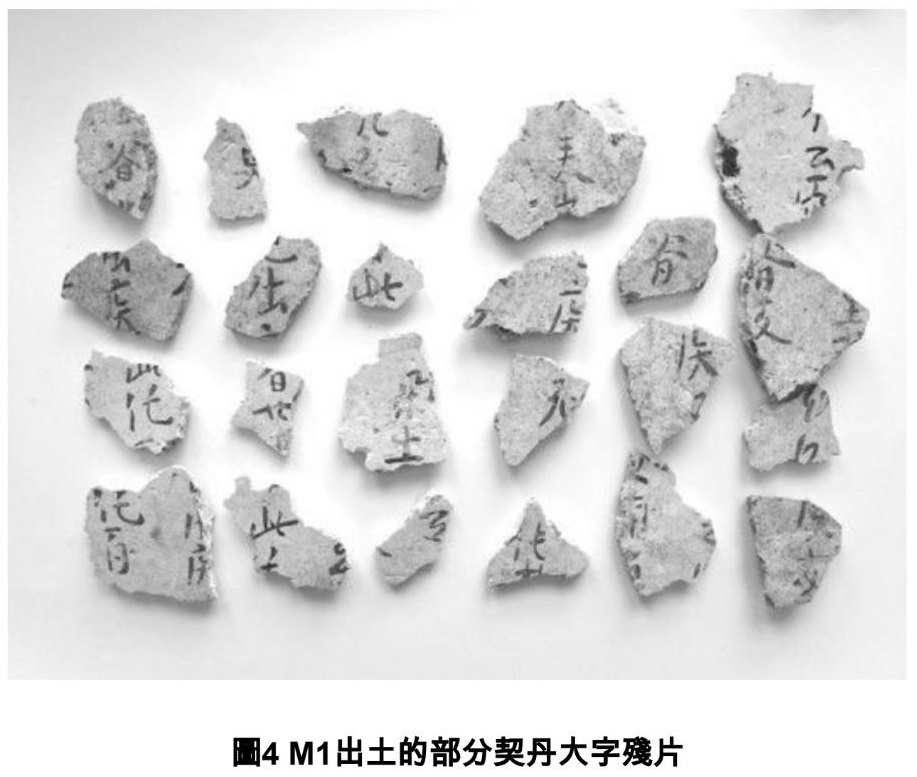BabelStone Blog
Saturday, 8 December 2018
Khitan Fragments from the Tomb of Yelü Pugu
Jinbaotun Cemetery
In 2016 two large tombs (designated M1 and M2) were excavated at the Jinbaotun cemetery 金宝屯墓地 in Kailu County in eastern Inner Mongolia. The excavation has been reported online in various places, for example:
- 内蒙古通辽市开鲁县发现辽代琉璃砖皇族墓葬 (September 2016)
- 内蒙古开鲁发现辽代琉璃砖皇族墓葬 (September 2016)
- Royal tomb constructed by glazed-bricks from Liao Dynasty found in Kailu, Inner Mongolia (November 2016)
- 内蒙古开鲁县辽代琉璃砖皇族墓葬 (March 2017)
Both tombs date to the Liao dynasty (907–1125), and the larger tomb, M1, has distinctive green glazed bricks, which had previously only been found in the tomb of Yelü Yuzhi 耶律羽之 (890–941), suggesting that this must be the tomb of someone very important.
Tomb M1 with green glazed bricks

Both tombs have been robbed several times, so very few tomb goods remain, although some of the looted burial goods were recovered by the police. However, some of the walls of the passageways and chambers of both tombs preserve the remains of murals, although most have already flaked off. What is most interesting is that a number of ink inscriptions in Chinese and Khitan characters have been preserved on the walls of the passageway for Tomb M1, reportedly amounting to more than a hundred characters in both scripts in total. The ink inscriptions in Chinese include the name 蒲骨 (púgǔ), from which the archaeologists have inferred that the occupant of M1 was Yelü Pugu 耶律蒲古 (d. 1031), a fourth generation descendant of the younger brother of Abaoji, founder of the Liao dynasty.
Mural of a Khitan man on the passageway of Tomb M1
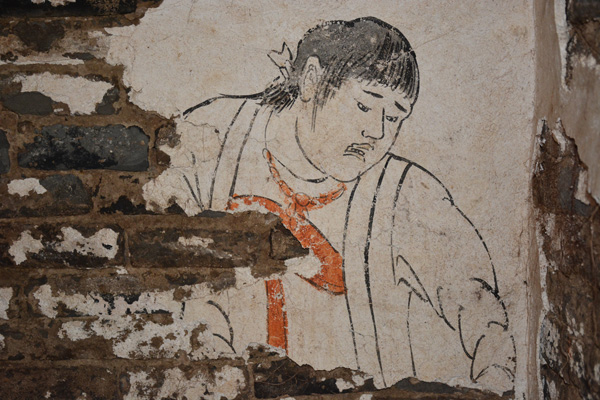
The online reports of the excavation do not specify whether the Khitan script written on the walls is Khitan Large Script [KLS] or Khitan Small Script [KSS] (see The Mystery of Two Khitan Scripts for details), or provide any details about how many inscriptions in Khitan were preserved. However, in September 2016 Jerry You posted a couple of photos of the Khitan inscriptions on twitter, from which it can be seen that the inscriptions are in the Khitan Large Script. Unfortunately, the inscriptions are very incomplete, and must only represent a small part of what was originally written on the wall. Nevertheless, the few Khitan characters that do survive are very clearly written.
This site is about 215 km north of the site of the Mausoleum for Emperor Jingzong where the KSS marble tablets that I discussed last week were found. The closest Khitan script remains found to date is the KLS epitaph for the Prince of the North 北大王 (Yelü Wanxin 耶律萬辛, 972–1041), whose tomb is about 45 km north-west of the Jinbaotun tombs.
Location of the Jinbaotun tombs
Approximate location: 43°37'33"N 121°36'44"E
Green tags are sites of Khitan Small Script finds
Yellow tags are sites of Khitan Large Script finds
Khitan Large Script Inscription A
This inscription consists of just three characters. They may be all that is left of a longer inscription, but I am inclined to think that these three characters are complete in themselves, and represent the name of the person who was originally depicted in the mural at this location.
KLS Inscription A
| No. | Glyph | N4631 | Notes |
|---|---|---|---|
| 1 |  |
1521 | Only elsewhere attested in the Epitaph for Yelü Xinie 耶律習涅 (1063–1114) line 24. Probably a variant form of  [0200] which occurs in the Epitaph for the Princess of Yongning Commandery 永寧郡公主 (1033–1091) line 12 and the Epitaph for Yelü Qi 耶律褀 (1033–1108) line 8. [0200] which occurs in the Epitaph for the Princess of Yongning Commandery 永寧郡公主 (1033–1091) line 12 and the Epitaph for Yelü Qi 耶律褀 (1033–1108) line 8. |
| 2 |  |
0386 | Possibly a borrowing of the Chinese character xiào 孝 "filial". This is a rare character that only elsewhere occurs in the Epitaph for Yelü Changyun 耶律昌允 (1000–1061) line 25, although the inscription is not very clear, so in Liu Fengzhu and Wang Yunlong's 2004 study of this inscription the character is transcribed like 芓. |
| 3 |  |
0819 | Quite a common character, frequently occurring immediately after  [1254] or [1254] or  [1726], often in contexts suggesting it is a name or a title. Although it looks like the Chinese character tián 田 "field", it is probably unrelated. Liu Fengzhu and Wang Yunlong 2004 propose the reading [ku]. [1726], often in contexts suggesting it is a name or a title. Although it looks like the Chinese character tián 田 "field", it is probably unrelated. Liu Fengzhu and Wang Yunlong 2004 propose the reading [ku]. |
If these three characters are a label identifying the name of someone depicted in the mural, the first character is probably a family name, and the second and third characters are probably his or her personal name. The collocation 
 also occurs in the Epitaph for Yelü Changyun 耶律昌允 (1000–1061) line 25, where it may also be a personal name. Yelü Pugu (d. 1031) was a contemporary of Yelü Changyun, and so it is not impossible that the same person is referred to in the two cases.
also occurs in the Epitaph for Yelü Changyun 耶律昌允 (1000–1061) line 25, where it may also be a personal name. Yelü Pugu (d. 1031) was a contemporary of Yelü Changyun, and so it is not impossible that the same person is referred to in the two cases.
Khitan Large Script Inscription B
The second inscription is more substantial than the first, and appears to comprise narrative text rather just a simple label naming someone depicted in the mural. There are two columns of text, although it is not clear whether these two lines are connected together in a single sentence or not. Unfortunately, most of this inscription has been lost, and only seven complete characters survive.
KLS Inscription B
| No. | Glyph | N4631 | Notes |
|---|---|---|---|
| 1 |  |
0759 | The identification is not certain. This is a rare character, which may be a mistake for  [0261] or [0261] or  [1767] meaning "elder brother" (derived from the Chinese character xiōng 兄 "elder brother"). [1767] meaning "elder brother" (derived from the Chinese character xiōng 兄 "elder brother"). |
| 2 |  |
0821 | This character occurs four times in the Epitaph for Dorlipun 多羅里本 (1037–1080); twice in the Epitaph for Yelü Xinie 耶律習涅 (1063–1114); and once in the Epitaph for Yelü Qi 耶律褀 (1033–1108). In all seven cases it immediately precedes  [0454], so the occurrence here in front of a different character is unexpected. The Epitaph for Yelü Qi also has [0454], so the occurrence here in front of a different character is unexpected. The Epitaph for Yelü Qi also has  [0997], immediately preceding [0997], immediately preceding  [0461], which may be the same character. Liu Fengzhu and Wang Yunlong 2004 propose that it is read [xwɑ], transcribing Chinese huà 化, but I do not know what the basis for this reading is. [0461], which may be the same character. Liu Fengzhu and Wang Yunlong 2004 propose that it is read [xwɑ], transcribing Chinese huà 化, but I do not know what the basis for this reading is. |
| 3 |  |
0748 | A common character, but its meaning is unknown. |
| 4 | ? | ? | Only part of the character remains so it is difficult to identify. Possibly one of:       . It is not exactly aligned with the previous three characters, so it may belong to a new inscription. . It is not exactly aligned with the previous three characters, so it may belong to a new inscription. |
| No. | Glyph | N4631 | Notes |
|---|---|---|---|
| 1 | ? | ? | Only a small part of a single stroke of this character survives. |
| 2 |  |
0580 | Identification not certain. Possibly a variant form of  [0547], a common character meaning "great". [0547], a common character meaning "great". |
| 3 |  |
1672 | Genitive suffix -ən for stems with a [ə] vowel. Extremely common character. |
| 4 |  |
1186 | Very common character. The sequence   [1729 1186] has been interpreted as meaning "female person", with the sense "wife". Liu Fengzhu and Wang Yunlong 2004 propose that 1186 is read [khu] on the reading of a Khitan Small Script character that may correspond to it. [1729 1186] has been interpreted as meaning "female person", with the sense "wife". Liu Fengzhu and Wang Yunlong 2004 propose that 1186 is read [khu] on the reading of a Khitan Small Script character that may correspond to it. |
| 5 |  |
1147 | Very common character, frequently occurring after 1186. |
| 6 |  |
1521 | Variant form of  [0670]. [0670]. |
The fourth and fifth characters of the second line of Inscription B 
 [1186 1147] are a very common term, occurring in at least six KLS epitaphs. Most studies of KLS epitaphs that I have seen do not translate this term, but in Liu Fengzhu's 2010 study of the Epitaph for the Prince of the North, in one place only he glosses the two characters as the official title zhīhòu 祗候 "Usher", which is defined by Hucker as "a [Song dynasty] title for eunuch attendants in the Palace Domestic Service serving at court audiences". That is to say, it was a junior position at court for meeting and greeting guests, and as there were no Khitan eunuchs at the Liao court, it could not have been a eunuch position if held by a Khitan. The basis for this gloss is the Chinese epitaph for the prince that is carved on the underside of the lid for the Khitan epitaph (the top of the lid is inscribed with the title "Tomb epitaph for the Grand Prince of the North" 北大王墓誌 in Chinese characters). Although the Chinese epitaph is not a translation of the Khitan epitaph (or vice versa), there are some parallel sections which aid in the decipherment of the KLS text.
[1186 1147] are a very common term, occurring in at least six KLS epitaphs. Most studies of KLS epitaphs that I have seen do not translate this term, but in Liu Fengzhu's 2010 study of the Epitaph for the Prince of the North, in one place only he glosses the two characters as the official title zhīhòu 祗候 "Usher", which is defined by Hucker as "a [Song dynasty] title for eunuch attendants in the Palace Domestic Service serving at court audiences". That is to say, it was a junior position at court for meeting and greeting guests, and as there were no Khitan eunuchs at the Liao court, it could not have been a eunuch position if held by a Khitan. The basis for this gloss is the Chinese epitaph for the prince that is carved on the underside of the lid for the Khitan epitaph (the top of the lid is inscribed with the title "Tomb epitaph for the Grand Prince of the North" 北大王墓誌 in Chinese characters). Although the Chinese epitaph is not a translation of the Khitan epitaph (or vice versa), there are some parallel sections which aid in the decipherment of the KLS text.
大王先娶達曷娘子,年十六而夭,生一子馬九,本王府司徒。再娶留女夫人,三十八終,生一子三部奴,祗候。又娶得...
The Prince first married a girl called Dahe, who died young at the age of 16, having given birth to a son called Majiu who became a councillor at the prince's court. Then he married Madam Liunü, who passed away at the age of 38, having given birth to a son called Sanbunu, who became an Usher. He also married ...
Chinese epitaph for the Grand Prince of the North, lines 4–6
Khitan epitaph for the Grand Prince of the North, lines 4–6
I have underlined in red some of the words we already know in the Khitan epitaph, translated below, and it is clear from this that the Khitan and Chinese texts correspond quite closely, but that the Khitan text provides additional details such as the ages of the sons when they attained their official positions:
Grand Prince ... wife ... 16 years old ... son ... 45 years old ... second wife ... 38 years old ... son ... 30 years old {Usher?} ... third wife ...
We could try to fill in the gaps, and provide meanings for most of the other Khitan words in this section of the epitaph, but for the present we are just interested in the Khitan word 
 (underlined in blue) which occurs immediately after "30 years old" and preceding the sentence about the third wife. The name of the son must be in front of "30 years old", so the KLS characters following "30 years old" should be his official rank, in which case
(underlined in blue) which occurs immediately after "30 years old" and preceding the sentence about the third wife. The name of the son must be in front of "30 years old", so the KLS characters following "30 years old" should be his official rank, in which case 
 should correspond in meaning to zhīhòu 祗候 "Usher" in the Chinese epitaph. The Khitan term is almost certainly not a phonetic transcription of the Chinese title because in the word wife
should correspond in meaning to zhīhòu 祗候 "Usher" in the Chinese epitaph. The Khitan term is almost certainly not a phonetic transcription of the Chinese title because in the word wife 
 the second character cannot plausibly be read as a phonetic transcription of a Chinese character pronounced like zhī.
the second character cannot plausibly be read as a phonetic transcription of a Chinese character pronounced like zhī.
The term 
 occurs a total of five times in the Epitaph for the Grand Prince of the North, but zhīhòu 祗候 "Usher" only occurs the one time in the Chinese epitaph, probably because the Chinese text is abbreviated compared with the Khitan text. That Liu Fengzhu only glosses one of the five occurrences of
occurs a total of five times in the Epitaph for the Grand Prince of the North, but zhīhòu 祗候 "Usher" only occurs the one time in the Chinese epitaph, probably because the Chinese text is abbreviated compared with the Khitan text. That Liu Fengzhu only glosses one of the five occurrences of 
 as zhīhòu 祗候 suggests that he may not be entirely convinced by the translation. Let us look at the occurrence on line 11 of the Khitan epitaph, which has no parallel in the Chinese epitaph:
as zhīhòu 祗候 suggests that he may not be entirely convinced by the translation. Let us look at the occurrence on line 11 of the Khitan epitaph, which has no parallel in the Chinese epitaph:
When [Yelü Wanxin] was 39 years old, in the 29th year of the Tonghe era [1011], Emperor Shengzong ... {Usher?} ...
Khitan epitaph for the Grand Prince of the North, line 11
In this example, it seems that Emperor Shengzong does something related to 
 when Yelü Wanxin was 39 years old (we can be sure the subject of the sentence is Yelü Wanxin as he died at the age of 69 in 1041). The most obvious interpretation would be that Emperor Shengzong appointed Yelü Wanxin to this position, but it seems unlikely to me that a Khitan aristocrat would be appointed to the menial position of Usher at the ripe age of thirty-nine, so perhaps there is some other explanation.
when Yelü Wanxin was 39 years old (we can be sure the subject of the sentence is Yelü Wanxin as he died at the age of 69 in 1041). The most obvious interpretation would be that Emperor Shengzong appointed Yelü Wanxin to this position, but it seems unlikely to me that a Khitan aristocrat would be appointed to the menial position of Usher at the ripe age of thirty-nine, so perhaps there is some other explanation.
In the History of the Liao Dynasty (Liáo Shǐ 遼史), the term zhīhòu 祗候 occurs about 160 times, but as an official title the vast majority of occurrences are as part of the official title zhīhòu lángjūn 祗候郎君 "Court Attendant Usher". The typical use is in biographies, where it is stated that in such a year or during such an era the subject of the biography filled a position as Court Attendant Usher (bǔ zhīhòu lángjūn 補祗候郎君), as in these examples:
- 蕭孝忠, ... 開泰中,補祗候郎君,尚越國公主,拜駙馬都尉,累遷殿前都點檢。
- 陳昭袞, ... 統和中,補祗候郎君,為奚拽剌詳穩,累遷敦睦宮太保,兼掌圍場事。
- 耶律和尚, ... 重熙初,補祗候郎君。
- 孝先, ... 統和十八年,補祗候郎君。
- 撻不也, ... 清寧二年,補祗候郎君,累遷永興宮使。
The position seems to have normally been given to young men at the start of their career, for example Oulisi 歐里思 is specified as "not yet having been capped" (wèiguān 未冠) and Yelü Shilu 耶律室魯 is specified as "just having been capped" (fǔguān 甫冠) when they were appointed as Court Attendant Ushers (the capping ceremony for young men occurs when they are about twenty years of age). However, some appointments were only made to men in their thirties, for example it is stated that when Xiao Changge 蕭常哥 was first appointed a Court Attendant Usher he was already aged more than thirty (年三十餘,始為祗候郎君), although perhaps his age is mentioned specifically because he was unusually old for his first official appointment.
The two KLS characters 
 have been interpreted as corresponding to the Chinese official title lángjūn 郎君 "Court Attendant", with the reading shali, for example in the Epitaph for Dorlipun and the Epitaph for Yelü Qi. In the KLS epitaphs I have examined, the two characters
have been interpreted as corresponding to the Chinese official title lángjūn 郎君 "Court Attendant", with the reading shali, for example in the Epitaph for Dorlipun and the Epitaph for Yelü Qi. In the KLS epitaphs I have examined, the two characters 
 never occur immediately next to
never occur immediately next to 
 , as might be expected if
, as might be expected if 
 means zhīhòu 祗候 "Usher".
means zhīhòu 祗候 "Usher".
The term 
 frequently occurs immediately in front of the character
frequently occurs immediately in front of the character  (in the extant monuments it is written in a range of glyph forms, but below I have standardized to the same glyph for all occurrences). In the inscription on the mural for Yelü Pugu, the character following
(in the extant monuments it is written in a range of glyph forms, but below I have standardized to the same glyph for all occurrences). In the inscription on the mural for Yelü Pugu, the character following 
 is evidently a variant of
is evidently a variant of  . This sequence of three characters is attested eleven times in KLS epitaphs that I have seen, and in all cases the sequence forms one of the two following four-character phrases, so there is a good chance that the last three characters of Inscription B line 2 are the first three characters of one of these two phrases:
. This sequence of three characters is attested eleven times in KLS epitaphs that I have seen, and in all cases the sequence forms one of the two following four-character phrases, so there is a good chance that the last three characters of Inscription B line 2 are the first three characters of one of these two phrases:



 [1186 1147 0670 0958] (eight occurrences in five epitaphs)
[1186 1147 0670 0958] (eight occurrences in five epitaphs)


 [1186 1147 0670 0099] (three occurrences in two epitaphs)
[1186 1147 0670 0099] (three occurrences in two epitaphs)
Images of rubbings from epitaphs of all the examples of these four-character phrases that I have been able to find are shown below (my thanks to Viacheslav Zaytsev for preparing the images).
| 1 | 2 | 3 | 4 | 5 | 6 | 7 | 8 |
|---|---|---|---|---|---|---|---|
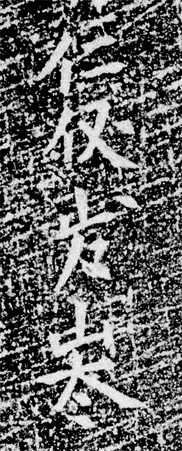 |
 |
 |
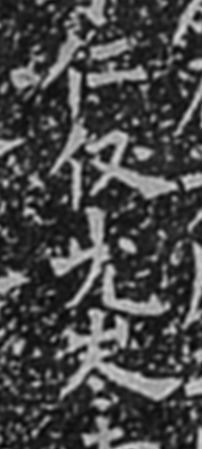 |
 |
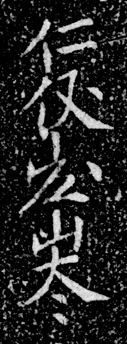 |
 |
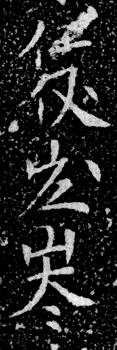 |
| Dorlipun line 9 |
Yelü Changyun line 11 |
Xiao Paolu lines 2–3 |
Xiao Paolu line 5 |
Yelü Qi line 10 |
Yelü Qi line 12 |
Yelü Qi line 15 |
Yelü Qi line 16 |
| 9 | 10 | 11 |
|---|---|---|
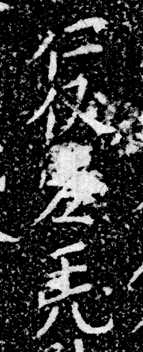 |
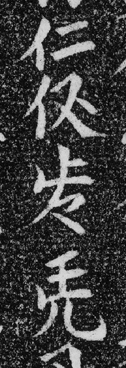 |
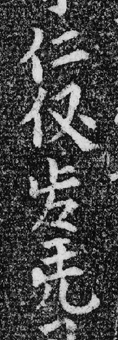 |
| Yelü Qi line 35 |
Yelü Xinie line 8 |
Yelü Xinie line 14 |
The table below gives the above examples in context, with a literal word-for-word translation into Chinese and a rough translation into English, as far as it is possible to do so given our limited understanding of the Khitan Large Script.
| No. | Text | Source |
|---|---|---|
| 1 |
重熙.皇帝.之時.於.□□□□... During the time of the Chongxi Emperor (i.e. Emperor Xingzong, 1032–1055), {????} ... |
Dorlipun lines 8–9 |
| 2 |
歲.三十二.於.□□□□...北院 At the age of 32, {????} ... Northern Establishment ... |
Yelü Changyun line 11 |
| 3 |
...相公.□□□□...郎君... ... Minister Duke {????} ... Court Attendant ... |
Xiao Paolu lines 2–3 |
| 4 |
宰相.歲.十九.於.□□□□... When the Grand Councilor was 19, {????} ... |
Xiao Paolu line 5 |
| 5 |
重熙.初.□□□□... At the start of the Chongxi era (1032–1055), {????} ... |
Yelü Qi line 10 |
| 6 |
四十...□□□□... forty ... {????} ... |
Yelü Qi line 12 |
| 7 |
...□□□□... ... {????} ... |
Yelü Qi line 15 |
| 8 |
清寧.六年.於.□□□□... In the sixth year of the Qingning era (1060), {????} ... |
Yelü Qi line 16 |
| 9 |
...□□□□... ... {????} ... |
Yelü Qi line 35 |
| 10 |
太尉.□□□□...郎君... The Defender-in-chief {????} ... Court Attendant ... |
Yelü Xinie line 8 |
| 11 |
大安.七年.歲.二十九.於.□□□□...院... In the seventh year of the Da'an era (1091), at the age of 29, {????} ... establishment ... |
Yelü Xinie line 14 |
In six out of these eleven examples (1, 2, 4, 5, 8, and 11), the terms 


 or
or 


 are preceded by a date and/or an age, and are consistent with a statement that somebody was given an official position at such a date or at such an age. The ages mentioned in three of the examples (19, 29 and 32) are consistent with a junior appointment, and match the range of ages for appointment as Court Attendant Usher given in the History of the Liao Dynasty discussed above. It is a great shame that there are no biographical entries in the History of the Liao Dynasty for any of the subjects of epitaphs discussed in this post, not even the Grand Prince of the North, so it is not possible to confirm what official positions they actually held.
are preceded by a date and/or an age, and are consistent with a statement that somebody was given an official position at such a date or at such an age. The ages mentioned in three of the examples (19, 29 and 32) are consistent with a junior appointment, and match the range of ages for appointment as Court Attendant Usher given in the History of the Liao Dynasty discussed above. It is a great shame that there are no biographical entries in the History of the Liao Dynasty for any of the subjects of epitaphs discussed in this post, not even the Grand Prince of the North, so it is not possible to confirm what official positions they actually held.
Conclusive evidence for the meaning of 


 and
and 


 is still lacking, but they should refer to some sort of junior official title. If the interpretation of
is still lacking, but they should refer to some sort of junior official title. If the interpretation of 
 as Court Attendant lángjūn 郎君 is incorrect, then perhaps
as Court Attendant lángjūn 郎君 is incorrect, then perhaps 


 refers to Court Attendant Usher (zhīhòu lángjūn 祗候郎君), and
refers to Court Attendant Usher (zhīhòu lángjūn 祗候郎君), and 


 refers to some other variety of Court Attendant (e.g. yùzhǎn lángjūn 御盞郎君 "Court Attendant in charge of the imperial cup, páiyìn lángjūn 牌印郎君 "Court Attendant for paizi and seals"), with the common element
refers to some other variety of Court Attendant (e.g. yùzhǎn lángjūn 御盞郎君 "Court Attendant in charge of the imperial cup, páiyìn lángjūn 牌印郎君 "Court Attendant for paizi and seals"), with the common element 
 meaning Court Attendant lángjūn 郎君.
meaning Court Attendant lángjūn 郎君.
Sources
- Epitaph for the Grand Prince of the North 北大王 (Yelü Wanxin 耶律萬辛, 972–1041)
- Epitaph for Court Attendant Dorlipun 多羅里本郎君 (1037–1080)
- Epitaph for Xiao Paolu 蕭袍魯 (1018–1089)
- Epitaph for Yelü Changyun 耶律昌允 (1000–1061)
- Epitaph for Yelü Qi 耶律褀 (1033–1108)
- Epitaph for Yelü Xinie 耶律習涅 (1063–1114)
Bibliography
- Cong Yanshuang 丛艳双, Liu Fengzhu 刘凤翥, Chi Jianxue 池建学. 2005. "Qìdān dàzì Duōluólǐběn lángjūn mùzhìmíng kǎoshì" 契丹大字《多萝里本郎君墓志铭》考释; Mínzú Yǔwén 民族语文 2005.4: 50–55.
- Jin Yongtian 金永田. 1991. "Qìdān dàzì Yélǜ Xíniè mùzhì kǎoshì" 契丹大字“耶律习涅墓志”考释; Kǎogǔ 考古 1991.4: 372–379.
- Liu Fengzhu 劉鳳翥 and Tang Cailan 唐彩蘭. 2003. "Liáo Xiāo Xīngyán mùzhì hé Yǒngníngjùn gōngzhǔ mùzhì kǎoshì" 遼“萧興言墓誌”和“永寧郡公主墓誌”考释 [A Decipherment of the Epitaphs of Xiao Xingyan and Princess Yongning of the Liao Dynasty]; Yenching Journal of Chinese Studies 燕京學報 vol. 14: 1–23.
- Liu Fengzhu 劉鳳翥 and Wang Yunlong 王雲龍. 2004. "Qìdān dàzì Yélǜ Chāngyǔn mùzhìmíng zhī yánjiū" 契丹大字《耶律昌允墓誌铭》之研究 [A Decipherment of Yelu Changyun's Epitaph in Qitan Large Characters]; Yenching Journal of Chinese Studies 燕京學報 vol. 17: 61–99.
- Liu Fengzhu 刘凤翥. 2006. "Qìdān dàzì Yélǜ Qí mùzhìmíng kǎoshì" 契丹大字《耶律褀墓志铭》考释; Nèiměnggǔ Wénwù Kǎogǔ 内蒙古文物拷古 2006.1: 52–78.
- Liu Fengzhu 刘凤翥. 2010. "Qìdān dàzì Běidàwáng mùzhìmíng zài kǎoshì" 契丹大字《北大王墓志铭》再考释. In Nie Hongyin 聂鸿音 and Sun Bojun 孙伯君 (eds.), Zhōngguó Duōwénzì Shídài de Lìshǐ Wénxiàn Yánjiū 中国多文字时代的历史文献研究 [Researches on Historical Records in the Periods of Multiple Scripts] (Beijing: Social Sciences Academic Press) pages 404–418.
Addendum [2023-01-22]
I have now been able to access a paper written by Changhai 長海 and Lian Jilin 連吉林 entitled 《開魯縣遼代皇族墓葬出土墨書題記相關問題初步研究》 [Preliminary research on issues relating to the ink inscriptions unearthed at the Liao dynasty aristocratic burial in Kailu county] which was published in 《西域歷史語言研究集刊》 [Studies in history and linguistics of the Western Region] (社會科學文獻出版社, 2019) vol. 12 no. 2, pp. 22–31. This paper includes the three photographs of detached fragments of plaster with ink inscriptions in Chinese and Khitan large script which are reproduced below.
Detached fragments of plaster with ink inscriptions in Chinese and Khitan
Khitan fragments on the left, and Chinese fragments on the right
Source: 《開魯縣遼代皇族墓葬出土墨書題記相關問題初步研究》 Fig. 3
Detached fragments of plaster with ink inscriptions in Khitan large script
Higher resolution images of 23 of the Khitan fragments
Source: 《開魯縣遼代皇族墓葬出土墨書題記相關問題初步研究》 Fig. 4
Detached fragments of plaster with ink inscriptions in Chinese
Higher resolution images of some of the Chinese fragments
Source: 《開魯縣遼代皇族墓葬出土墨書題記相關問題初步研究》 Fig. 5
I discuss these fragments in detail in a forthcoming paper (Two recent discoveries of fragments of Khitan inscriptions) which expands upon my two Khitan blog posts of this year (this blog post and a post on the marble slips from the Liao Mausoleum at Yiwulü Mountain), and corrects some errors of interpretation.
Last modified: 2023-01-22
Index of BabelStone Blog Posts
